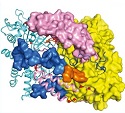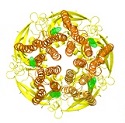Vol. 19, No. 6 - February 2019
View the Archives

Important Announcement Regarding Foreign National Access to Department of Energy FacilitiesAs many of you are aware the Department of Energy has issued a new International Science & Technology Engagement Policy to be implemented across the DOE complex, including labs, sites and plants. This policy comes in response to increasing intelligence about the targeting by foreign entities of U.S.-funded basic research and technology for international economic and national security advantages. The specific details and mechanisms to support these changes are still under discussion and being defined. Senior leadership at SLAC and Stanford are actively working with DOE to address and understand potential impacts of this policy. So far the main impacts of supporting this policy include:
Please also reference Foreign Visitors: Documents Required for Check-in at SLAC Science Highlights
Mechanism of Thiopurine Resistance in Acute Lymphoblastic Leukemia – Contacts: Chelsea L. Dieck, Liang Tong, and Adolfo A. Ferrando, Columbia University Acute lymphoblastic leukemia (ALL) is an aggressive malignancy of the bone marrow that currently stands as the most common form of cancer in children. DNA sequencing studies comparing diagnostic and relapse patient samples have identified relapse-driving mutations in the cytosolic 5’-nucleotidase II (NT5C2) gene. The role of the NT5C2 enzyme is to degrade purines so they can be exported from the cell. NT5C2 can also degrade and inactivate thiopurine chemotherapy molecules, causing resistance to ALL treatments. Read more...
Structural Basis of Neurosteroid Anesthetic Action on GABAA Receptors – Contact: Pei Tang, University of Pittsburgh School of Medicine General anesthetics like alphaxalone (5α-pregnan-3α-ol-11,20 dione) bind to type A γ-aminobutyric acid receptors (GABAARs), which are gated ion channels that reduce the potential of neurons to fire. Experimental evidence points to GABAAR’s transmembrane domain (TMD) as the allosteric site of drug binding. The TMD is known to be responsible for allowing the ion channel to transition between the resting, activated, and desensitized states. A team of scientists has studied where alphaxalone binds to GABAAR and how this affects its function. Read more... SSRL-Related NewsNIST Metrology Initiative Excerpt from February 4, 2019 SLAC Today article by Glennda Chui A metrology initiative begun five years ago by the National Institute of Standards and Technology (NIST) and Stanford University is now part of the SSRL Directorate. Called the Joint Initiative for Metrology in Biology, or JIMB (pronounced Jim Bee), it’s now being operated by SLAC in partnership with NIST. The initiative brings together experts from NIST, Stanford, SLAC and Silicon Valley to advance metrology – the scientific study of measurement – by creating foundational measurement tools and standards for bioscience and biotechnology in support of NIST’s mission to promote U.S. innovation and industrial competitiveness. “The goal is to make our amazing measurement capabilities more reliable, informative and trustworthy so scientists can share their results with more confidence and make faster progress,” says Marc Salit, the center’s co-founder and director. “JIMB represents an exciting opportunity for SLAC to partner with NIST,” says Kelly Gaffney. “Analytical methodology and measurement is at the heart of SLAC’s and SSRL’s mission, making NIST a natural partner. We also look forward to using JIMB’s activity to broaden our interactions with industry.” JIMB is funded by NIST under a 5-year interagency agreement with DOE. AnnouncementNew Multi-Technique Proposals (Pilot) A new Multi-Technique Proposal mechanism has been created for structural biology-related projects that require the use of two or more scientific techniques available at SSRL (both x-ray and electron based). The pilot proposal mechanism will initially cover Small Angle X-ray Scattering, Macromolecular Crystallography and Cryo-Electron Microscopy. A goal is to expand the mechanism in its permanent phase to include additional techniques available at LCLS and spectroscopy and imaging methods at SSRL. The new pilot proposals will require a thorough justification for the requirement of using two or more techniques. The proposals will be reviewed by an ad hoc Proposal Review Panel comprised of members from the SSRL SMB and Cryo-EM PRPs. The new proposal template will be available June 1 and the first deadline for submission will be July 1. Upcoming Events and CoursesU.S. Particle Accelerator School June 17-28, 2019 The next program of the university-style credit courses will be sponsored by the University of New Mexico to be held in Albuquerque, New Mexico on June 17-28, 2019. website Joint SSRL/LCLS Users’ Conference September 25-27, 2019 – Call for Workshop Topics by March 18 We are beginning to plan for the next joint SSRL/LCLS Users' Conference to be held here at SLAC September 25-27, 2019, and we need your input! Please send us suggestions for full or half-day workshop topics for the conference. Include a working title, brief description of the science area or topics that could be discussed, and potential organizers. We would also appreciate your suggestions for keynote talks or potential speakers. Please contact SSRL UEC members or the User Office to share your input. EMSL Integration 2019 – Plants, Soil and Aerosols: Interactions that tell stories of Ecosystems, Climate and National Security” October 8-10, 2019 announcement User Research AdministrationProposal Deadlines SSRL
See SSRL Proposal & Scheduling Guidelines Cryo-EM
LCLS
Submit proposals for all three facilities through the User Portal. _____________________________________________________________________ The Stanford Synchrotron Radiation Lightsource (SSRL) is a third-generation light source producing extremely bright x-rays for basic and applied research. SSRL attracts and supports scientists from around the world who use its state-of-the-art capabilities to make discoveries that benefit society. SSRL, a U.S. DOE Office of Science national user facility, is a Directorate of SLAC National Accelerator Laboratory, operated by Stanford University for the U.S. Department of Energy Office of Science. The SSRL Structural Molecular Biology Program is supported by the DOE Office of Biological and Environmental Research, and by the National Institutes of Health, National Institute of General Medical Sciences. For more information about SSRL science, operations and schedules, visit http://www-ssrl.slac.stanford.edu. To unsubscribe from SSRL Headlines, just send an e-mail to listserv@slac.stanford.edu with "signoff ssrl-headlines" in the body. To subscribe, send an e-mail to listserv@slac.stanford.edu with "subscribe ssrl-headlines" in the body. Questions? Comments? Contact Lisa Dunn
|


